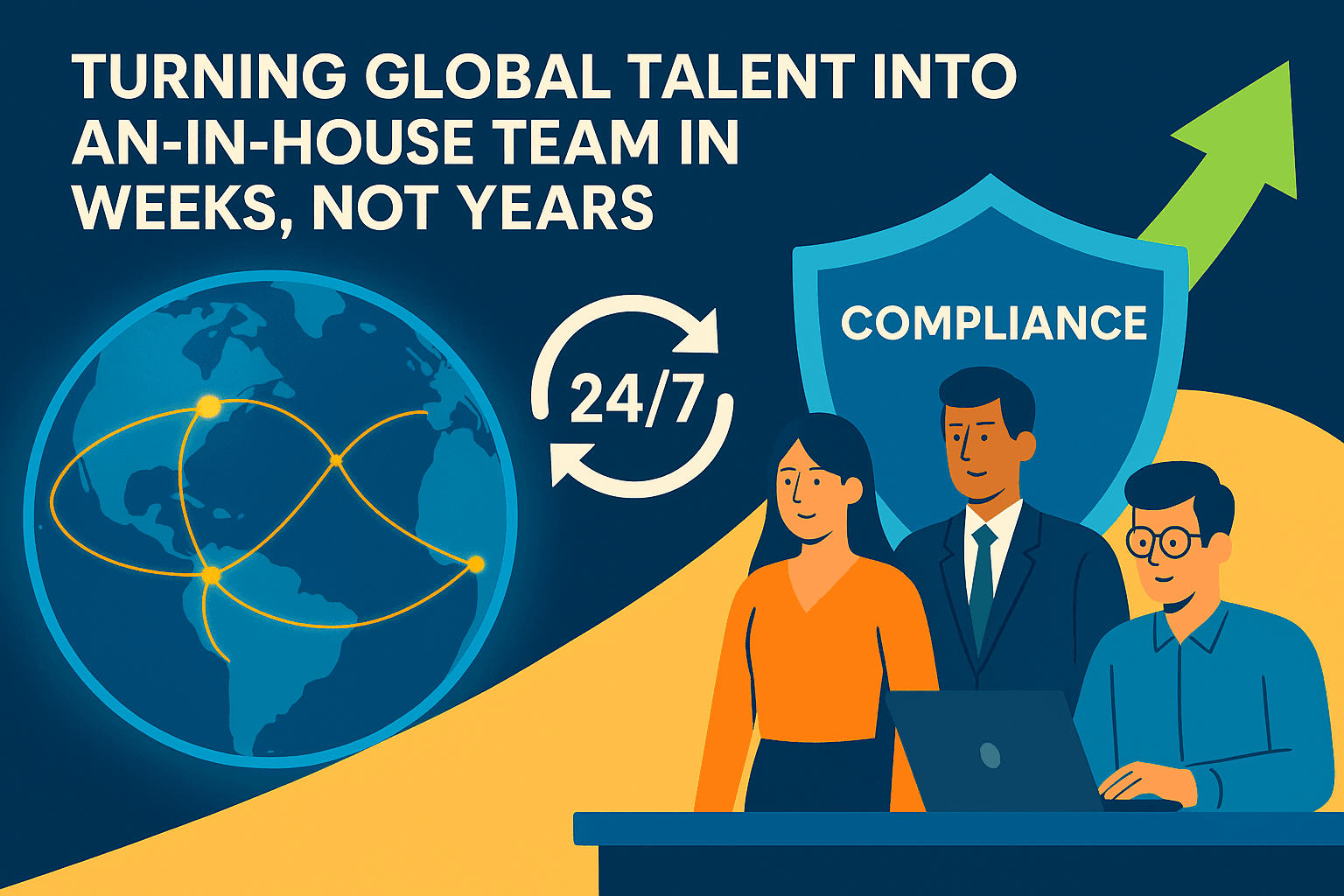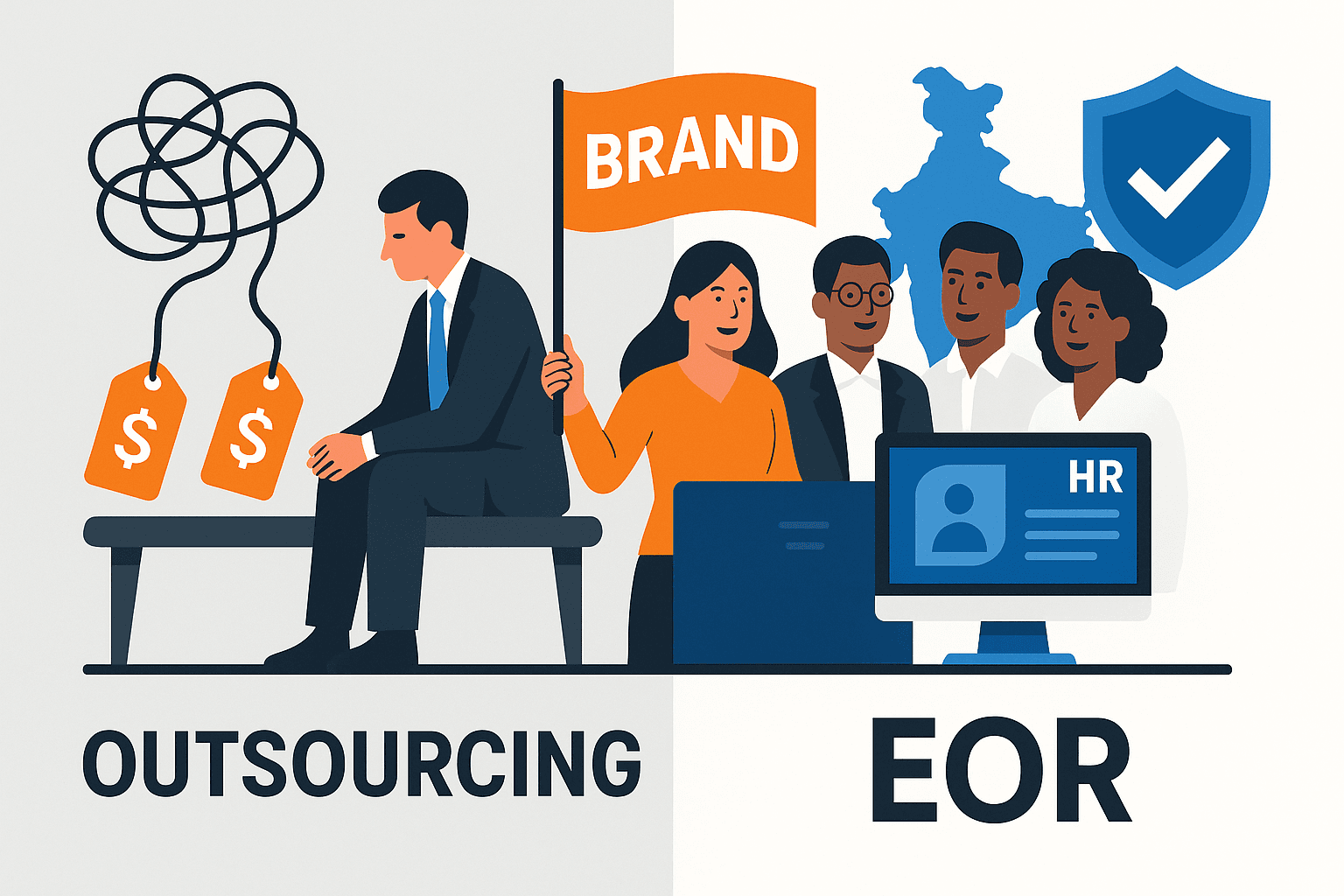Top Rippling competitors compared: How Kaamwork stands apart
Discover how Kaamwork outperforms Rippling competitors with faster, cost-saving global hiring and direct access to top Indian talent—empower your international workforce today.
ByNilesh@kaam.work / October 30, 2025 / 10 min read

With businesses in the U.S. adopting the concept of global talent acquisition, companies like Rippling, Deel, Remote, and talent-curated networks like Toptal have become increasingly popular. However, behind the scenes, these Rippling competitors tend to incur upfront expenses, protracted onboarding, and access to superior full-time professionals. Although one of the earliest unified HR and payroll providers was Rippling, many others copy or innovate with different advantages, disadvantages, and pricing structures.
Within such a congested arena, Kaamwork does stand as a next-generation solution: quick employee recruitment, high-quality talent, minimal or no local entity need, and unmatched access by the employer, all without the hassle of the traditional EORs. This blog explores each of the leading competitors and explains why the model used by Kaamwork can be useful to U.S. decision-makers aiming at the dynamic Indian technology workforce.
Understanding Rippling and its main alternatives
To make a comprehensive comparison, it is necessary to comprehend what Rippling and its key competitors offer to global hiring and workforce management.
Rippling at a glance
Rippling was established in San Francisco and is known to have a single platform; it is a combination of HR, payroll, IT, and finance. It automates onboarding/offboarding compliance, cross-country payroll, and device provisioning. Rippling sustains both contractors and EOR full-time employees, but, most importantly, it would frequently demand entity establishment, particularly not of North America.
Common use cases:
- Worldwide team management
- Benefits processing and tax compliance.
- Device and permission onboarding
Limitations:
Rippling features are powerful, but its modular pricing might be expensive as features are introduced. There is a high rate of integration problems and delays in the onboarding of users, especially when venturing into countries such as India. Furthermore, sourcing and vetting of talent is indirect, commonly going through agencies or marketplaces, the onboarding process for currently employed talent, and introducing platform fees.
Other popular competitors
Several platforms compete with Rippling in the global HR business, but with some strengths and weaknesses:
Deel
Leading EOR; quick contractor onboarding, but still needed to set up an entity, which required FTEs; transparent pricing with overhead.
Pros:
- Quick contractor recruitment in 150+ countries.
- Clear pricing to contractors and full-time employees of EOR.
- Conforming contracts and local payroll.
Cons:
- Requires the local establishment of full-time workers in specific key markets.
- Ongoing overheads and platform fees.
- Limited capability in providing a customized benefits package or localizing in India.
Remote
International presence (170+ countries), well-established compliance, flat-rate EOR, and flexibility, but it portrays a lack of flexibility and customized benefit assistance.
Pros:
- Simplification of budgeting through a flat-rate EOR pricing model.
- It is covered in more than 170 countries, and this is a guarantee of good global compliance.
- Well-developed HR and payroll automation.
Cons:
- Limited ability to onboard the process for benefits and contracts with Indian employees.
- Standardized onboarding experience, no personal touch by HR.
- Inadequate integration with U.S. domestic payroll and HR systems.
Papaya Global
Strong AI-driven payroll; good reporting and analytics; enterprise-level, as opposed to start-ups in the U.S.
Pros:
- AI-based advanced payroll for multinational teams.
- Intense analytics, compliance, and workforce cost reporting.
- Customized to suit high volumes and enterprise environments.
Cons:
- More appropriate when a large-scale business is involved than when dealing with agile U.S. startups.
- Expensive because of the high-end positioning of enterprise products.
- It takes additional time and effort to adapt to Indian HR and tax environments.
ADP Workforce Now
The legacy model of payroll has good compliance but is kind of complex and modular. Decreased satisfaction with user experience, interface, and integration.
Pros:
- Reliable international payroll and compliance professional with extensive local regulatory expertise.
- Modular solutions designed to suit complex global organizations.
- Scalable for large HR teams
Cons:
- The platform may be too elaborate and challenging to use.
- Reduced user satisfaction with the new UI, integration, and onboarding.
- Reduced speed of deployment in case of companies joining India or expansion of technical teams.
Gusto, BambooHR, Workday, Paychex, and Paylocity
They target various markets (SMB, enterprise, and compliance-heavy), and in most instances, they focus more on payroll than on global hiring.
The following are the pros and cons of each of the main Rippling competitors, including both the leaders in EOR and the primary HR tech giants, and a clear distinction is made:
Pros:
- Payroll and benefits management that is easy to use and operate (SMB, enterprise).
- Simple onboarding in domestic operations.
- Inexpensive and simple for U.S.-only or local needs
Cons:
- Lack of robust hiring or compliance support in Indian/global markets.
- Restricted to payroll and had little capacity to facilitate recruiting, onboarding, or localized HR.
- Multinational integration dilemmas.
Typical Drawbacks Across Most Platforms
- The majority of them lack thorough and local onboarding or practical HR services in India.
- Most of them provide indirect or agency-sourced access to real, full-time local talent.
- Operation costs can be greatly affected by platform and compliance fees.
- Incorporation into workflow, technology stack, and human resources in the U.S. can be tedious and painful.
This will assist U.S. decision-makers in understanding that although Rippling competitors add much-needed automation and compliance, most of them fail to provide direct, high-quality access to Indian full-time professionals, fast hiring, and on-the-job HR alignment functions that Kaamwork provides.
Curated talent platforms and outsourcing alternatives
The alternative model, curated talent platforms (Toptal, Upstack) and IT outsourcing giants (Cognizant, Infosys), provides a different model: short-term contractors or project teams rather than permanent hires.
Pros:
- Quick sourcing for specific skill sets
- Flexibility in consulting and projects
Cons:
- Hit-or-miss talent quality
- Contractor attitude and low involvement.
- Costs are increased with markups and management fees.
- Limited direct influence in the hiring, reviews, and day-to-day management
These methods can be too limiting or unsuitable for the overall objectives of growth for decision-makers who seek payroll and culture, and strategic control.
Why companies seek alternatives to Rippling
Rippling and its competitors scale to most use cases, but there are plenty of companies that have distinct pain points as they expand into international operations, particularly in high-skill markets, such as India.
Talent quality issues
Most EOR and HR sites have access to pools of contractors or staffing agencies' lists, yet, indeed, the most elite, full-time talent—those who are actually employed in setup companies worldwide—are usually inaccessible. This leads to limitations:
- Applicants are not always blue-chip professionals but former contractors.
- The engagement models are not long-term full employment but rather term-based.
- There is a possibility that the employees are not invested in the company culture or product outcomes.
Kaamwork responds by purchasing top talent at major companies—Amazon, Expedia, Microsoft—making it more committed and aligned.
Hidden costs and slow timelines
The most common delay in U.S. firms that hire in new areas is entity setup. It can take 1-3 months to comply, register a company, and negotiate benefits on popular EORs and platforms. Add surprise onboarding fees, inflexible contracts, and layered platform subscription rates, and the budget impact grows.
- Rippling and others can be charged per module/user, increasing the total cost.
- Deel, Remote, and Papaya are transparent in fees but conceal operational overhead in entity setup.
- Rippling/Deel requires 6-12 weeks of setup, whereas Kaamwork allows hiring in 24 hours ("Day Zero Model")
Lack of local HR touch
Automated onboarding and remote payroll might be acceptable at the entry level, but a high-impact hire requires local HR support:
- Elaborating on Provident Fund (similar to U.S. 401(k)), ESIC (healthcare), and Gratuity (loyalty bonus) in terms that are U.S.-friendly.
- Field inquiries about work permits, equipment, family benefits, and relocation.
- Securing continued interest and retention.
Kaamwork integrates technology-based onboarding with local human resources specialists to make all the remote employees feel truly supported, reducing the risk of attrition.
How Kaamwork stands apart from Rippling and other competitors
Unlike generic platforms, Kaamwork fuses speed, savings, talent quality, and control for companies embracing Indian talent.
Speed—start hiring on day zero
The Day Zero approach by Kaamwork implies that firms would be able to look through pre-verified profiles and start the interview process. No weeks of waiting for compliance vetting or local entity formation.
Example workflow:
- Assess requirements
- Get 2-3 high-quality candidate profiles within less than 24 hours
- Interview and offer
- Payroll, benefits, and compliance start instantly through Kaamwork EOR
Where Rippling and competitors take too long to onboard because of regulatory challenges, Kaamwork takes only a short time before getting access without compromising compliance integrity.
Cost-effectiveness—save up to 50–80%
Conventional platforms charge payroll, entity, and integration charges and benefits. Kaamwork does not have a subscription fee or various pay levels; it is a flat fee per employee, thus making it truly cost transparent.
Comparison:
- U.S. salary: The average pay of a senior engineer is $130,000/year.
- Kaamwork model: Equivalent skill for $50,000–$60,000/year in India, including all statutory benefits (Provident Fund, Gratuity, ESIC)
This is 50-80% savings and does not include U.S.-based overheads such as benefits administration and compliance consulting.
Access to top-tier talent
Kaamwork recruits teams of professionals who are already thriving in large companies (Amazon, Flipkart, Microsoft), who are recruited on a full-time basis - not gig workers or agency staff.
- Engineers, product managers, and data scientists sourced from real employers
- Face-to-face interviews and pre-employment background checks.
- Cultural fit evaluations are made in an attempt to be permanently integrated into the U.S. teams.
This is in contrast to talent platforms (Toptal, Upstack) or outsourcing consultancies (Infosys), which are more likely to sell transient contractors at a higher markup rate.
Full control and ownership
With Kaamwork, hiring managers retain authoritative power over:
- Interview format and selection criteria
- Performance appraisals
- Decisions regarding promotion, firing, and compensation
- Team culture and work assignments
This autonomy is a contrast to the outsourcing and EOR platforms, which limit direct management.
Local HR expertise with a human touch
The model of Kaamwork places local HR expertise in the forefront. Onshore, payroll, tax, compliance, and statutory benefits are processed, whereas onboarding and engagement are handled by real people.
- The employees receive assistance in dealing with Indian labor requirements (Provident Fund, ESIC, and Gratuity).
- Multi-channel HR services to address questions and build a sense of belonging.
This guarantees a high retention and smooth performance by remote hires.
Kaamwork versus Rippling competitors: side-by-side comparison
| Decision Factor | Rippling & Major EORs | Kaamwork |
|---|---|---|
| Entity setup | Often required or delays | Not required |
| Time to hire | 6–12 weeks | 24 hours – 5 days |
| Talent pool | Contractors/agency employed | Full-time premium professionals |
| Cost | Moderate (10–30% savings) | 50–80% total cost savings |
| Local onboarding | Automated | Human-led support |
| Control | Limited/indirect | Direct and full ownership |
| Employee status | Contractor/FTE mix | Full employment only |
| Statutory benefits | Varies, often limited | All Indian statutory benefits |
The speed, savings, control, and best talent combination of Kaamwork will make it very appealing to growth-stage U.S. firms interested in India.
Success stories with Kaamwork
- “Finding great talent globally is hard. Kaamwork has been a fantastic partner to work with for this challenge. They make the entire lifecycle frictionless, from locating top talent to interviewing, onboarding, and administration. They have developed a handful of innovative working models that are truly win-win-win for talent, company, and Kaamwork. I’d highly recommend them.”
Osi Peters,
VP of Engineering & Head of Data Science and Analytics, Tripadvisor
- “KaamWork helped me find the right fit in a new team at the right time. It doesn’t matter where you live, especially during these tough times, enabling people across the world to have different timelines and cultures. They are an end-to-end package guiding you through the process from the interview process to the onboarding process, payroll management, HR requirements, and health insurance providers, among other services. This made me worry-free while working remotely. They have great support, just a message away to help you.”
Ravi Chandra,
Data Scientist, Regie AI.
These stories demonstrate Kaamwork’s ability to balance rapid global expansion and talent quality—two areas where most Rippling competitors struggle.
Common objections and Kaamwork’s response
Here’s how Kaamwork responds to the most frequent concerns from global employers:
We have experimented with India, and it has not paid off
Previous experience with contractors or agencies usually fails because of not being directly employed and poor control. Kaamwork takes the U.S. companies directly to the full-time premium talent, solving the engagement and output issues.
Time zones are challenging
Thousands of international corporations achieve seamless collaboration across the U.S. and Indian time zones. Kaamwork recommends working hybrid schedules and facilitating synchronous team processes to fuel productivity and engagement.
We’re not interested in outsourcing
Kaamwork is neither outsourcing nor an agency; it is an open EOR and direct-hiring model. The selection, reviews, and culture remain in the hands of the employers--Kaamwork only handles the statutory and payroll bureaucracy.
Is Kaamwork right for your company?
The choice to Kaamwork--and outgrowth of Rippling competition--lies in a sincere evaluation of your team's needs, development strategies, and objectives of international expansion.
Company size and growth stage
Kaamwork is ideal for businesses with:
- 50 or more employees or $50M+ annual revenue.
- Several technical or analytical positions are scheduled to be hired globally.
- A cost-cutting and best talent acquisition strategy in new markets.
Roles suited for the Kaamwork model
Software engineering, data analytics and machine learning, product management, design, marketing, and operations are the most appropriate functions at Kaamwork. The roles can be best applied in firms that are interested in developing high-performance in-house teams instead of overseeing transactional outsourced projects. This emphasis will bring about a better level of alignment, long-term commitment, and an almost smooth integration with international teams.
The majority of the most appropriate functions are:
- Software engineering
- Data analytics and machine learning
- Product management
- Design and marketing
- Operations
The model is also suitable for firms that want to establish in-house high-performing teams and not transactional, outsourced project employees.
Most suited functions include:
- Software engineering
- Data analytics and machine learning
- Product management
- Design and marketing
- Operations
The model is also suitable when the company is seeking to establish high-performing in-house teams as opposed to the transactional staff who are outsourced to undertake project work.
Strategic fit
Companies that prioritize:
- Speed and agility in global hiring
- Premium full-time professionals at your fingertips
- Full autonomy of team organization and effectiveness
- Trusted HR cooperation and compliance on the local level will have the model of Kaamwork fit their best operations
Why Kaamwork is the smarter choice
Kaamwork reinvents the hiring methods of U.S. organizations that want to recruit in India. Speed, cost-efficiency, talent quality, and unrestrained control are the core values of it.
- Hiring immediately—no local company necessary.
- Cost savings of 50-80 percent of domestic or EOR payroll.
- Tap into vetted full-time professionals of major corporations.
- Keep direct control over all HR and performance decisions.
- Onboarding and benefit support with human-led automation and supplement technology.
Kaamwork is a successful case study, and customer satisfaction demonstrates that its model is faster, more compliant, and higher-quality team building than any other major Rippling competitor.
Are you willing to change your global talent strategy?
Explore Kaamwork for full-time, world-class hiring in India now!



